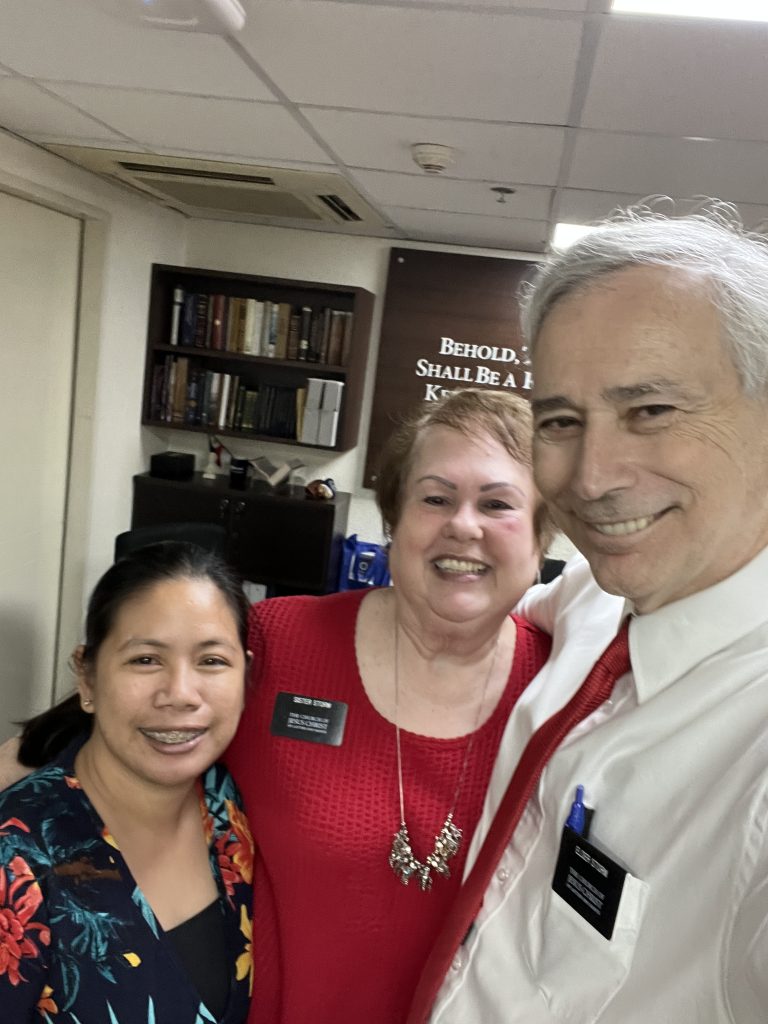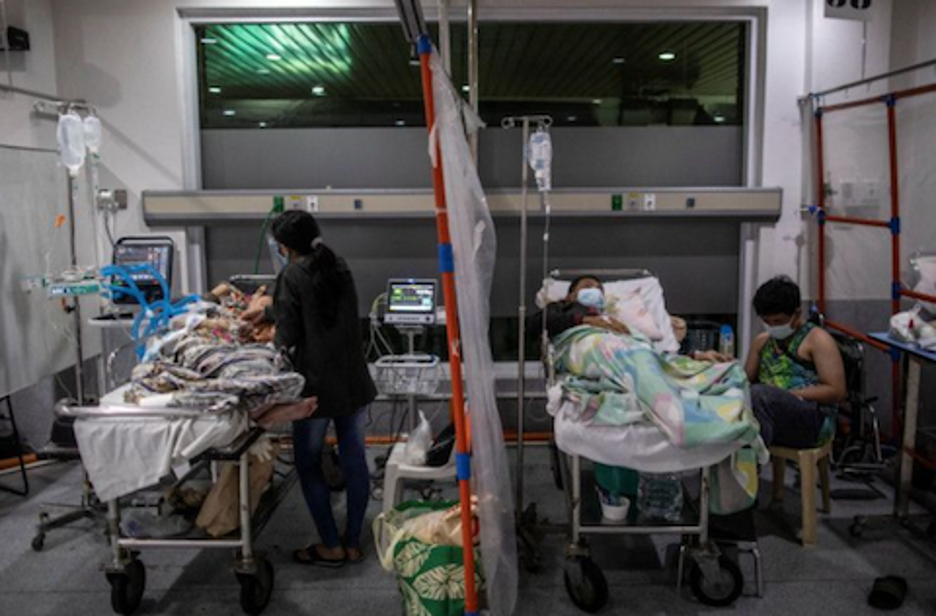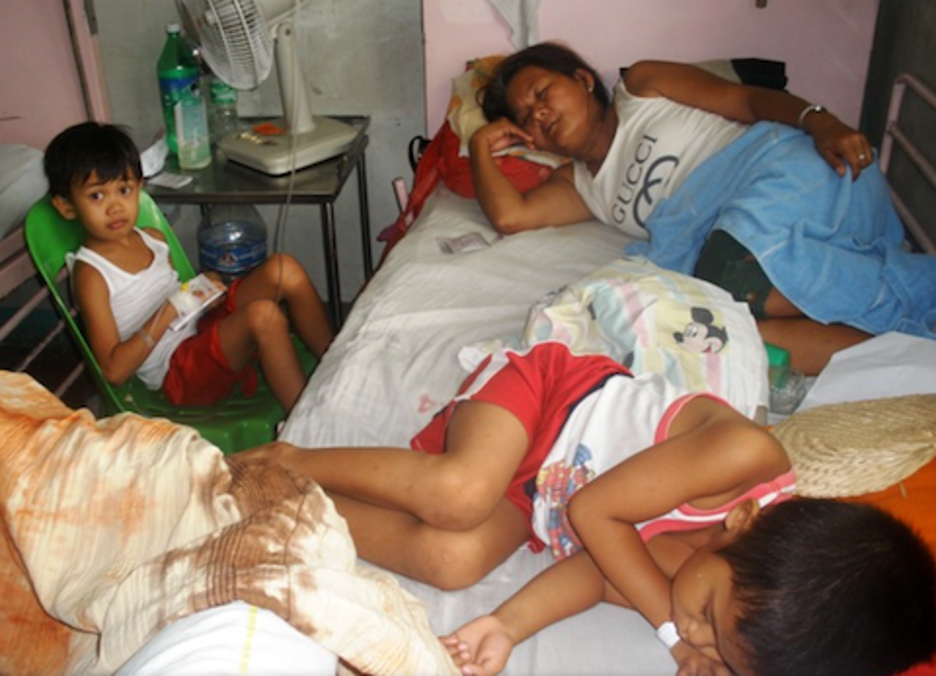When we are not in the field and are working in the Area Office working, we often have lunch in the cafeteria. There are approximately 120 people that work in the Area Office, including the teachers at Mission Training Center (missionaries have their own cafeteria), maintenance and grounds staff, and all administrative, finance, and HR personnel, and the Area Presidency all work in the Area Offices. The cafeteria is staffed by three people, two full-time young ladies and one young man, who works part time.
Lunch is served from 10 am to 1:30 pm five days a week. The menu is traditional Filipino food which includes four types of protein including chicken, beef, pork, and fish – complete with the fish head intact – I don’t know what kind of fish that’s served because I’ve never asked and I don’t have the fortitude to eat the fish while it is staring at me. Of course, there is always white rice. In fact, white rice is served with every meal including breakfast and plenty of it. There’s one or two servings of veggies some of which I’ve never heard of but they’re generally very good.
We had a young man do some intern-like work in our office for about a month. We bought his lunch. He always had a double, and sometimes a triple, serving of white rise and one small portion of protein. White rice, while having marginal nutritional value, is deeply engrained in the Filipino cultural. I’ve asked several Filipinos why they don’t like brown rice (which we prepare when having rice at home cook in our very own rice cooker) and they look at us as if we were from another planet. I’m sure they are thinking, “Why would they ask such a dumb question?”. Even when I’ve tried to explain that many of the nutrients are removed through a polishing process of brown rice to make white rice, they dismiss this as false doctrine.
Annabelle (she goes by Ann) is one of the young ladies that works in the cafeteria. We’ve become friendly with her because we see her at least two and as many as four days a week. She’s very pleasant and is always happy to see us.
One of the projects we are currently working on is finding and interviewing sister missionaries that served their missions between 2012-2015 as a part of the Church History Department’s Worldwide Collection Project. The Church History Department selects a topic each year to collect data about for future research. A part of this research is recording oral history interviews. The collection project for 2023 is to document the insights of sister missionaries related to the age change of missionary service of Elder’s ages from 19 years old to 18 years of age and the Sister’s age from 21 years old to 19 years of age for missionary service eligibility. We have interviewed five sister missionaries as a part of this Worldwide Collection Project.
A few weeks ago, Ann was finishing her shift (she arrives at 4 am) she stopped by our office to say “Hi.” In a brief interchange, she mentioned that she served a mission, something that we didn’t know or quite frankly didn’t suspect (shows you how people can surprise you when you make uninformed assumptions). I asked her when she served. She told us that she served her mission between 2013-2015 – the sweet spot for the Worldwide Collection Project. When I learned this, I asked her if she would consent to an interview by us.
As I’ve shared with you in past posts – and will likely do so again, Filipino saints are just so faithful and this; constantly reoccurring theme continues to keep us humble. Here are a few highlights of her life and what we learned from Ann.
She is the only church member in her family. Her parents separated while she was young and she was raised by her grandmother along with of her two cousins. The missionaries knocked their door and eventually her grandmother and Ann were baptized but her cousins were not. She was a good student and received a full ride scholarship to a private university – relatively few of these scholarships are awarded in the area where she lived. Her mission call came the same week she received notice of her scholarship. Since she had limited means to pursue her education on her own, the scholarship was a huge deal. Yet, she made the difficult decision to decline the scholarship and serve a mission. Many of her family and friends didn’t understand her decision. She served her mission in the Olongapo Philippines Mission about three hours northwest of Quezon City. At the time of her call she lived in the central islands of the Philippines called Visayas.
After her mission, she enrolled in university and graduated with a degree in secondary education, working full-time while going to school. She had considered engineering prior to her mission but found that her passion was in teaching because of experiences she had on her mission….her goal now is to become a teacher.
While on her mission, she became good friends with a young man who had a girlfriend. I get the impression she was offering advice to him related to her girlfriend relationship problems and she probably provided a shoulder to cry on as the relationship began to go south after he returned home from his mission. After this young man’s relationship with his girlfriend didn’t work out, they started seeing each other and she received a marriage proposal on the Cebu Temple grounds. They were married in the Manila temple, have one child, and her husband is a senior at a local university working on his degree in Business Management with an emphasis on Operational Logistics. When he graduates, she plans to pursue her master’s in education.
Interviewing her was a delight because when you have a chance to talk to someone and ask questions about their life experiences you learn insights that wouldn’t normally be shared with you.
In Ann’s case, when I asked her about how the change in age impacted the sisters and elders she served with she had some insightful observations. Her trainers were much older than her because they entered the mission field at a minimum age of twenty-one, and some were older than that, and they had serviced for over a year when they became her trainer. This is a significant difference between a nineteen year old and a twenty four year old+ is substantial. She candidly said that the maturity and focus of the older missionaries was very evident and noticeable. Because of this, they set a good example for the younger missionaries. As the mission migrated to the younger missionaries, she said that the silliness and happy times attitude of the eighteen-year-old elders and nineteen year old sisters was noticeable. It took time for these missionaries to mature….an insightful comment from a young serious minded sister missionary such as Ann.
I asked her if she considered her mission a success and if so, could she share an example of this success. She was almost insulted that I would ask this type of question responding indigently, “Of course, I had a successful mission!”
She shared that she was able to find and teach several great families, one of which was a family with fourteen that were baptized and (although she was hesitant to talk about this) this wasn’t the only large family she helped find the gospel.
After we finished this interview, and I thought of our interviews with mission leaders as they shared their feelings about their Filipino missionaries, I’ve concluded that the future of the Church in the Philippines is secure because of the army of future leaders that are being prepared by the missionary program. After interviewing Ann, this fact was reinforced and I can see this becoming a reality before our eyes because I can tell that she will have an impact on those around her wherever she teaches and lives.

Things that we continue to learn about the Philippines….
Hospital Watchers
In the US when someone in the family is sick and needs to go to the hospital, a family member usually goes to the hospital with their sick family member and admits them, hang around for a while, leave returning during visiting hours to check in on how things are going. While in the hospital, nurses, doctors, and the medical staff are the ones who take care of us. While some families in the US have family and friends stay in the hospital to ensure the patient is adequately represented and properly cared for, this is not always the case.
Things are a little different in the Philippines.…
The following is a common scenario in the Philippines.
When a sick family member needs to be hospitalized, at least two people go to the hospital with the person being admitted into the hospital – one of these people is the “watcher”.
The hospital watcher is ideally a close family member responsible to care of the patient and stays with them in the hospital. They are responsible for the following:
– Getting updates from nurses and doctors on the condition, procedures, and patient instruction.
– Making medical decisions or getting medical decisions directly from family members authorized to do so.
Because of this, the watcher is usually also someone who:
– Can (or has to) take time off from work often leading to this person quitting their job because family responsibility is stronger than working.
– Isn’t working outside of the home.
– Someone who can work remotely will often work from the hospital room. Being a hospital watcher is often hard and time consuming. For this reason, the family often share the “watcher duties” with several relatives. However, there’s usually a main watcher; they are the ones who will stay overnight, remain at the bedside most of the time, knows the patient best, and can make medical decisions if needed.

Watchers are always near their family member in the hospital – day and night.
Private hospitals in the Philippines don’t require patients to have watchers and prefer that family don’t have watchers. However, because of a culture of strong family ties, most people can’t bear the thought of having their loved ones alone in the hospital cared for by strangers, even if these strangers are medical professionals with years of experience providing round-the-clock care. Their logic is that nobody can really take care of you like family.
The exception is government (public) hospitals. Here patients there are required to have a watcher because they don’t have enough medical personnel to constantly monitor the patients. In some hospitals, they are so used to having watchers around that these hospitals provide food and hygiene kits for the watchers. In these situations, most patient rooms have couches or small beds for the watcher. Some fancier private hospitals even have closets for the watcher to store clothes or a kitchenette for simple food prep.
While hospital know that watchers may not be necessary, many Filipinos are thankful that their mom, husband, uncles, aunts, and other extended family members are their watchers.
There are benefits of having a watcher(s):
1.) Not having to call the nurse to help you go to the restroom, have a drink, or make me more comfortable.
2.) On their rounds doctors can just ask the watcher if there is an authorization needed to perform a procedure and get an instantaneous decision.
3.) The likelihood of getting good postpartum or postop care because watchers are there asking the nurses questions on what to do and watching them learning how to do it properly.
4.) Also, the idea of a stranger bathing someone in the family is very uncomfortable to a Filipino. Even if that stranger is a nurse. Keeping the patient clean when this is a watcher around is easier because they are always there to clean up after an accident or mess.
Since the Philippines is the outsourcing capital of the world and many Filipino often work virtually. When this happens, family members who work from home often become on-call watchers, while their family members are working or getting much needed rest. These on-call watchers will often work from the hospital room. Many hospitals have also gotten used to online workers as watchers because some hospitals provide good Wi-Fi so watchers can work while watching.
Being a hospital watcher is often hard and time consuming. For this reason, the family often share the “watcher duties” with several relatives. However, there’s usually a main watcher; they are the ones who will stay overnight, remain at the bedside most of the time, knows the patient best, and can make medical decisions if needed.
There’s also a downside with watchers. Some families can overdo it. One of the biggest complaints from hospitals is there are too many watchers for just a single patient. This can create an overcrowded situation. While the intent is good, the outcome is can be degraded.

Watchers can multiply and this crowding issue can lead to unhealthy situations
When there are too many watchers, this can stress out the patient and increase the risk of infection. This was evident in the early days of the Covid pandemic when many contracted Covid in the hospital while being a watcher.
Many hospitals have gotten stricter of allowing too many watchers in hospitals. They also impose strict “no watchers” policy in places like the ICU or quarantine areas to minimize patient stress and infection.
On thing that I’ve come to appreciate and stand in amazement at how strongly Filipinos feel about their family obligations. The entire concept of family in the Philippines is different than the concept of a traditional family in the US. There is something so basically good about the Filipino concept of family. This is one reason why the gospel concept of “the eternal nature of the family and that families can be together forever” resonates with Filipinos.
Scriptural thought: Alma 37:37 “Counsel with the Lord in all of they doings, and he will direct thee for good….”
Spiritual Thought: There is no promise of equality in outcome, only equality in opportunity.
